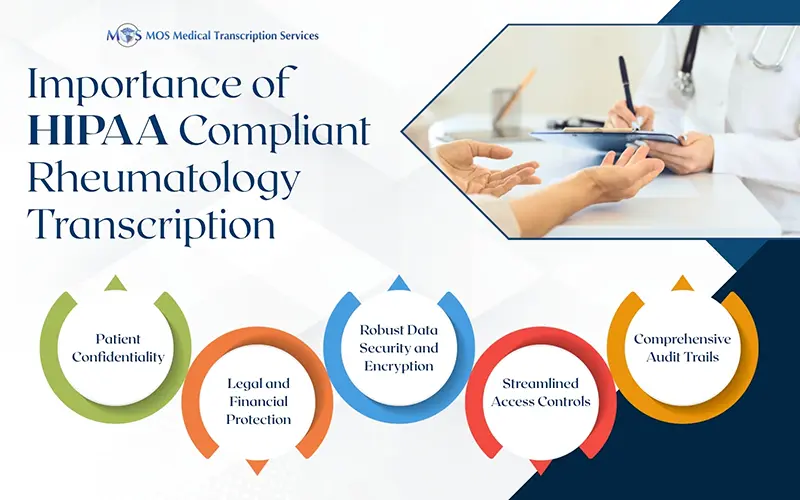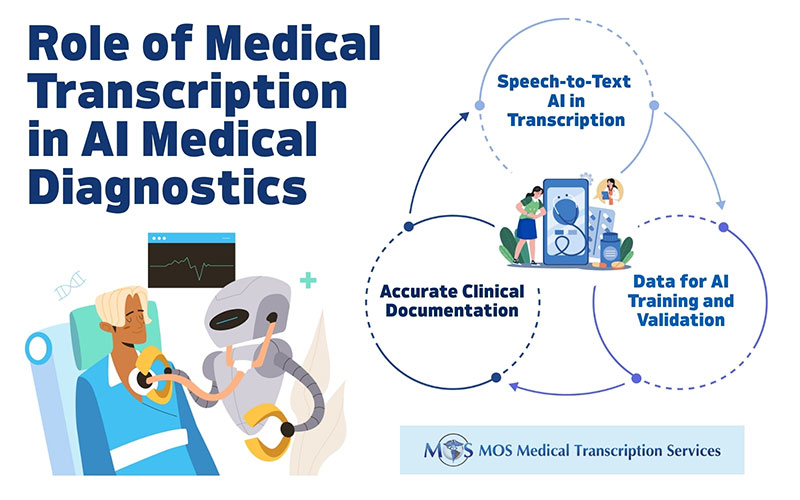
Table of Contents
Reviewing accurate and current medical records enables clinicians to skip repetitive patient questions, initiate treatment promptly, and minimize the risk of errors at all costs. Not only is it crucial for your healthcare facility’s operations and care, but it is also a key part of billing insurance companies for the cost of the care provided. This is why it is a practical decision to invest in a medical transcription service to create consistent and accurate documentation of recorded material. It is also useful for attorneys to quickly identify a case’s advantages and disadvantages.
Significance of Accurate Medical Documentation
According to the Journal of AHIMA, the main goal of documentation in hospitals is to guarantee that patients receive the treatment they require by providing medical professionals the data they need to make informed decisions. A patient is likely to interact with many medical staff members while undergoing treatment, which include doctors of different specialties and nurses. If a patient needs ongoing or follow-up care, he/she may also visit a provider at another facility.
Medical records may include imagery from technicians that the patient may not even have spoken to and results of lab tests. In addition to the treatments that have previously been given, the patient’s file should also include a diagnosis and treatment strategy. Medical records that are clear and precise guarantee that the patient will receive proper care from any doctor or nurse who is starting their shift. Additionally, it aids in avoiding improper medication administration. The treatment strategy aids in ensuring that the patient receives the additional attention required to make a full recovery or manage an ongoing condition.
| Learn more: Medical Transcription Improves Medical Documentation in Hospitals |
Effective Medical Documentation Tips:
- 1. Utilize the talents of your team: Not everything needs to be documented by you; strategically incorporating your team can save hours. A nurse or medical assistant, for instance, can record allergies, review prescriptions, and record patient outcomes. You can easily check the accuracy of this information before signing the memo.
- 2. Establishing professional norms: The first step in improving clinical documentation is for a practice to establish note-taking policies that adhere to accepted industry standards. In a recent paper, the American College of Physicians (ACP) outlined several methods that healthcare professionals can use to enhance their documentation. According to the authors, practices should establish policies based on “professional norms determined by consensus and specific to each specialization.” When creating practice guidelines, they advised doctors to put clarity, conciseness, and the needs of other readers first.
- 3. Finish up the bulk of the paperwork in the space: Summarize what you’ve said to the patient while taking or dictating notes while you discuss their medical history or treatment plan. Speaking your dictation aloud is effective and can interest the patient while enhancing understanding and ensuring accuracy. Many healthcare professionals have discovered that dictating clinical notes during patient visits has significantly streamlined their recording process.
- 4. Develop peer-to-peer support networks: It’s a good idea to designate a physician leader to lead documentation improvements in order to lessen dependency on EHR vendors or outside training. A peer-to-peer help mechanism will be established once there is a staff member who is knowledgeable about optimal documentation techniques. This person must be committed to the mission and knowledgeable about emerging note-taking techniques. He or she will become the go-to person for queries from doctors or support personnel and can assist the office to be on the same page with documentation.
- 5. Know the requirements for E/M documentation: A thorough system review or comprehensive examination is not necessary for a 99213 level of service. Family doctors who treat Medicare patients utilize this code 61 percent of the time. Save time by following the rules and simply documenting what is required for the present day’s visit in terms of medicine.
- 6. Employ fundamental EHR features: Examine whether you utilize your EHR’s time-saving features. For example, templates are useful for frequent visits where clinical inquiries are expected. In complicated or dynamic scenarios, manual typing or mobile dictation could be the fastest option. However, if it’s flu season, save time by making a simple template for your influenza vaccine.
- 7. Don’t strive for perfection: For people who are obsessive “box-checkers” and perfectionists, the EHR can be a huge pile. Consider the documentation requirements and make it straightforward. You don’t have to fill out every category on each visit, and not all boxes need to be checked. Recognize what matters and ignore everything else.
- 8. Tune the “opus“: Write down whatever information you wish you had but doesn’t exist on a sticky note while you examine previous notes in preparation for the next visit. After a few days, you might start to see certain trends, such as “explain the mechanism of damage” or “register the name of the caregiver.”
- 9. Monitor yourself: To determine how long it takes to finish a note, set a timer on your watch or smartphone. Set a target to reduce the time you spend documenting each patient after knowing your baseline. Speed shouldn’t be your main priority; taking more time to record appointments with unfamiliar or challenging patients may be beneficial.
Maintaining accurate medical records is essential to lower the risk of malpractice and ensure that the hospital can bill effectively. Accurate documentation ensures that services and treatments can be paid correctly to the patient or insurance provider. Medical dictation transcriptions must be accurate in order to guarantee proper patient care. These records, which are a part of the medical chart, are crucial for billing and payment purposes. For medical practitioners, patients, and insurance companies that analyze medical claims, high-quality transcription is crucial and medical transcription outsourcing services include individualized medical transcribing solutions.


